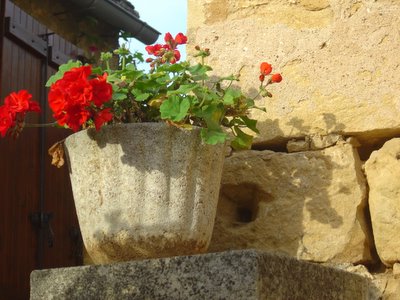
|
|
|
|
|
Home » All posts
Friday, November 4
from dawn to dusk........


Captive dans tes yeux
Qui m'as l'me ravie
D'un souris gracieux
Viens tot me secourir
Ou me faudra mourir.

Posted by
Unknown
Thursday, November 3
Food for body and soul

Links:
TAGS: Perigord France
chateau Learn French GourmetActivity Holidays
Posted by
Unknown
Wednesday, November 2
All Saints, All Souls & Crysanthenums.....

During the last two weeks of October, while the rest of the world is decked out in gaudy and ghoulish orange and black, spiders and bats, cobwebs and pumpkins, every little market in every town and village across France is ablaze with colour and the smell of fresh flowers.
Is there a special love for chrysanthenums in pots? I wondered. What a lovely gift for friends! I decided. And then I filled my chateau with small and medium and giant pots of flowers, a riot of colour on these grey misty autumn days. Thank the gods I refrained from handing them out to friends -- quelle horreur!---- bad enough that I put them in my house!..............
For then I discovered what it was all about...
November 1st is All Saints’ Day for Catholics and many Protestants, a holy day since the early Medieval times.
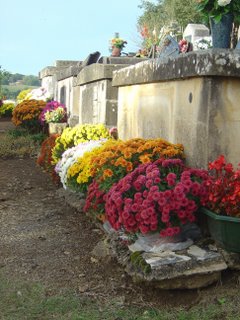 Many people of Europe spend this day in prayer, thanking God and praying to saints and visit their departed loved ones in cemeteries........... with a pot of chrysanths in hand........
Many people of Europe spend this day in prayer, thanking God and praying to saints and visit their departed loved ones in cemeteries........... with a pot of chrysanths in hand........----- and that is the only place a respectable pot of chrysanths will ever be seen!
In predominantly Catholic countries such as France, Toussaint, or All Saints’ Day on November 1 is a public holiday. Practicing Catholics are required to participate in Mass. And then, both religious and non-religious people crowd into cemeteries to honour their dead relatives and also long-departed heroes of their respective nation’s history. Even in countries where All Saints’ Day is not a public holiday, masses of people visit cemeteries, and government officials will turn part of the day into a secular remembrance.
Unlike the fun atmosphere of Halloween, All Saints’ Day is generally a quiet day of reflection and reverence. Krakow adds one exception, with its annual All Saints’ and All Souls’ Jazz Festival, demonstrating that there is more than one way to observe the past.
And then comes All Souls' Day, another Roman Catholic day commemorating the faithful departed or those baptized Christians believed to be in purgatory. It is celebrated on November 2 unless this date falls on a Sunday. When this happens, All Souls' Day is celebrated on November 3.
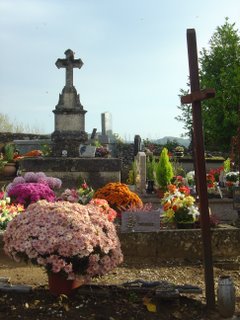 Before becoming a church festival in 998 C.E., it was marked with celebrations from the festival of Woden (Odin) as god of the dead: parading the Hodening wild horse and other guising including mummers' plays enacting the mysteries of life, death, and rebirth. Ceremonial soulcakes were cooked and eaten on this day. Odilo, abbot of Cluny, established All Souls' Day in the eleventh century and ordered it to be observed throughout the Cluniac monasteries. The day purposely follows All Saints' Day in order to shift the focus from those in heaven to those in purgatory. It spread through the rest of Christendom by the end of the thirteenth century. The origins are linked to an ancient festival of the dead. In Europe it is believed that on this night the dead visit their homes and eat the food of the living. Candles are left burning and "soulcakes" are left out. In Britain, on the eve of this night "soulers" would once go from house to house saying prayers for the dead and asking for soulcakes. It was believed that the more cakes you could eat, the more souls you could save from purgatory. Also known as Day of the Dead, especially in Mexico, where families picnic at the graves of their dead relatives, and give the children toys, bread and sweets in the shapes of skeletons or caskets. In Madagaskar, the bones of dearly departed are taken out of their tombs, put on a large sheet and 'aired' by throwing them up in the air while joyously walking through the streets! The pagan origins of this holiday are mentioned in The Pagan Book of Days by Nigel Pennick.
Before becoming a church festival in 998 C.E., it was marked with celebrations from the festival of Woden (Odin) as god of the dead: parading the Hodening wild horse and other guising including mummers' plays enacting the mysteries of life, death, and rebirth. Ceremonial soulcakes were cooked and eaten on this day. Odilo, abbot of Cluny, established All Souls' Day in the eleventh century and ordered it to be observed throughout the Cluniac monasteries. The day purposely follows All Saints' Day in order to shift the focus from those in heaven to those in purgatory. It spread through the rest of Christendom by the end of the thirteenth century. The origins are linked to an ancient festival of the dead. In Europe it is believed that on this night the dead visit their homes and eat the food of the living. Candles are left burning and "soulcakes" are left out. In Britain, on the eve of this night "soulers" would once go from house to house saying prayers for the dead and asking for soulcakes. It was believed that the more cakes you could eat, the more souls you could save from purgatory. Also known as Day of the Dead, especially in Mexico, where families picnic at the graves of their dead relatives, and give the children toys, bread and sweets in the shapes of skeletons or caskets. In Madagaskar, the bones of dearly departed are taken out of their tombs, put on a large sheet and 'aired' by throwing them up in the air while joyously walking through the streets! The pagan origins of this holiday are mentioned in The Pagan Book of Days by Nigel Pennick. And in France more pots of chrysanthenums are bought...
On this day, three requiem masses are celebrated: one for the celebrant, one for the departed, and one for the pope.
(and there should probably be a fourth one -- for the newcomers who have so much to learn still!)
TAGS: markets France
chateau holidays
Posted by
Unknown
Tuesday, November 1
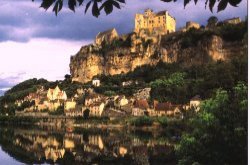
The site of Beynac and its castle is undoubtedly one of the finest in France. The village where Paul Eluard was born is built in stages above the water's edge, at the bottom of a 150 metre cliff, topped by an impressive fort. This eagle's nest might seem rather austere if it were not for the sun lighting up its golden walls, mirrored by the Dordogne. With its changing colours and the luminosity of the stone, the sky and the water, Beynac is a paradise for painters and photographers in all seasons.
Following the Organization of the county of Périgord. it became the seat of one of the four baronies along with Biron. Bourdeilles and Mareuil. The first unquestionable trace of a seigneur of Beynac dates back to 1115. The castle was so powerful and its barons so cruel that local vassals and peasants named it "Satan's ark".
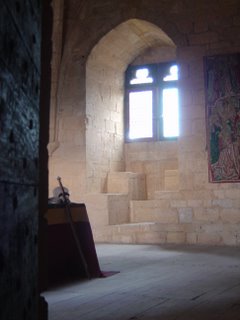 Richard the Lion Heart used this castle as his base, but in 1214, on return from a crusade against the Albigensians. Simon de Montfort took possession of Beynac, whose seigneur at the time was a friend of Raymond de Toulouse, and razed its defenses.
Richard the Lion Heart used this castle as his base, but in 1214, on return from a crusade against the Albigensians. Simon de Montfort took possession of Beynac, whose seigneur at the time was a friend of Raymond de Toulouse, and razed its defenses.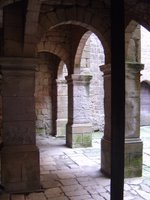

The Hundred Years War found Beynac in the French camp. In 1360, the Bretigny treaty transferred it by right to English rule but eight years later it returned to the fore of the fighting on the side of Charles V. The English were never able to capture the citadel. In 1370, the sole heiress of the fief, a three year old girl is promised in marriage to her uncle, Pons de Commarque who drove the English out of the Sarlat region and became the most powerful seigneur in Périgord.
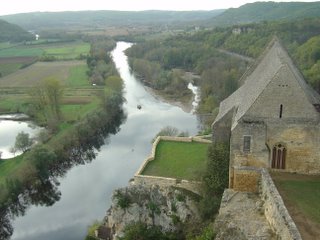 The castle was totally protected by the sheer drop on the side facing the river and its northern defenses were reinforced around 1598. A double surrounding wall, two rows of moats and two barbicans were built. From the top of the tower there is a breathtaking view over the whole of the valley and the surrounding Châteaux of Castelnaud, Fayrac, and Marqueyssac. On the edge of the cliff is the stone-roofed Romanesque castle chapel, the location of the famous scene from the 1978 version of "Les Miserables". More recently Luc Besson's The Messenger: The Story of Joan of Arc was shot here with Milla Jovovich. Imagine using the original and genuine site of historic events that happened hundreds of years ago -- and not having to change a thing for the sake of the big screen movie!
The castle was totally protected by the sheer drop on the side facing the river and its northern defenses were reinforced around 1598. A double surrounding wall, two rows of moats and two barbicans were built. From the top of the tower there is a breathtaking view over the whole of the valley and the surrounding Châteaux of Castelnaud, Fayrac, and Marqueyssac. On the edge of the cliff is the stone-roofed Romanesque castle chapel, the location of the famous scene from the 1978 version of "Les Miserables". More recently Luc Besson's The Messenger: The Story of Joan of Arc was shot here with Milla Jovovich. Imagine using the original and genuine site of historic events that happened hundreds of years ago -- and not having to change a thing for the sake of the big screen movie!
Posted by
Unknown






